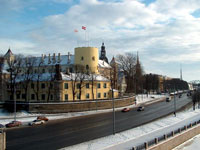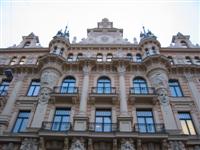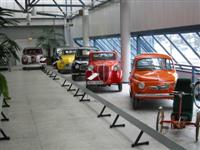The enchanting city of Riga, capital of Latvia and the biggest city in the Baltic States, has emerged from behind the Iron Curtain and is slowly coming into its own as a tourist destination. Situated on the south-western coast of the country, Riga is split in two by the River Daugava, and served as a major trading port and a crossroads between Western Europe and the East. The modern founding of the city dates back to the 12th century with the arrival of German traders, mercenaries and missionaries, while its older roots date back to a settlement of the ancient Finnic tribe, the Livs.
The city, and Latvia as a whole, was long caught in a tug of war between the Germans and the Russians, and suffered greatly in World War II when roughly a third of the country's population was exterminated, displaced or fled Nazi persecution. Despite this, Riga boasts a collection of exquisite Art Nouveau buildings that rival those in Vienna, Barcelona and St Petersburg, and the fairytale historic city centre is a delight to explore.
As the cultural and economic centre of the country, Riga is home to plenty of top-class museums, galleries and performing arts centres, as well as a range of sophisticated bars, clubs and restaurants. The city is fast gaining a reputation as a party capital, and its vibrant nightlife draws hundreds of weekenders from all over Europe.
For a more traditional Latvian experience, it is well worth braving the winter cold to enjoy a spot of ice fishing, ice skating on the frozen Daugava River or a pirt, a rigorous sauna that involves being beaten with dried birch branches. With over 800 years of history, a UNESCO World Heritage Site listed historic city centre and a modern buzz, Riga remains a largely undiscovered gem with plenty to delight and enchant the visitor.
Attractions
Riga Castle (or Riga pils) was built in 1330 on the site of the original settlement of the city, as a residence for the master of the Livonian Order, and later it served as the base for the city's occupiers throughout its history. The distinctive yellow castle was destroyed and rebuilt over time and today it serves as the offices and home of the Latvian president, as well as the Latvian Museum of Foreign Art and the Rainis Museum of Literature and Art History. The castle is strategically placed on the banks of the Daugava, originally in order to oversee all ships entering the city's port, and has four towers and an inner courtyard.
| |  |
Dating back to 1211, the red brick Dom (or Dome) Protestant Cathedral is a highlight of the historic centre of Riga. The cathedral is situated near the Western Daugava River and boasts an incredible organ with over 6,500 pipes built in 1844, stained glass windows and a beautifully whitewashed interior. There are regular concerts held on the organ, and the cathedral also has its own boy's choir that gives regular performances.
| |  |
| Open Air Ethnographic Museum |
The Open Air Ethnographic Museum is a fascinating reflection of the traditional Latvian way of life. Set on 247 acres (100ha), the museum consists of farmhouses, fishing villages, windmills and other historic buildings that have been relocated here to create an outdoor exhibit. Visitors can watch craftsmen at work, sample traditional Latvian cooking and ales, and learn more about the history of the country.
| |  |
One of the oldest and biggest of its kind, Riga's Central Market dates back to 1201 and is a riot of sounds, sights and smells. Anything from fresh fruits, cheeses, and whole sheep carcasses, to appliances, clothing and CDs are on offer, usually at very reasonable prices. The market was moved from its original home and relocated several times, but since the 1930s has occupied the same space in several World War I hangars, close to the bus and train stations. There is room for over 1,000 vendors, and no visit to Riga is complete without a stroll through its tantalising stalls.
| |  |
Riga is the world's best preserved open-air museum of Art Nouveau (also known as Jugendstil) architecture which dates from the early 20th century. The style is characterised by unusual shapes, curved and organic arches, gargoyles, and flamboyant cornices. Over 30 percent of central Riga's buildings were created in this style, many supervised by famous Russian architect Mikhail Eisenstein. The best streets to view buildings on are Elisebetes, Strelnieku and Albert.
| |  |
Europe's finest motor museum is tucked away on the outskirts of town and makes for an essential outing if you enjoy classical cars and Soviet history. The museum contains Molotov's limousine, Stalin's bombproof sedan, the wreck of Brezhnev's car in which he crashed. The model dummies in the vehicles are a nice touch. There is a priceless collection of classic sports cars and motorcycles - irresistibly photogenic for petrol heads.
| |  |
| The Museum of the Occupation of Riga |
Latvia was occupied from 1949 to 1991 by two successive regimes in Nazi Germany and Soviet Russia. This well curated museum conveys what life was like during this time, and serves as a memorial to those who died or fled as a result of the occupation. Visitors can view film archives and see a reconstruction of life in the infamous Siberian labour camps.
| |  |








No comments:
Post a Comment